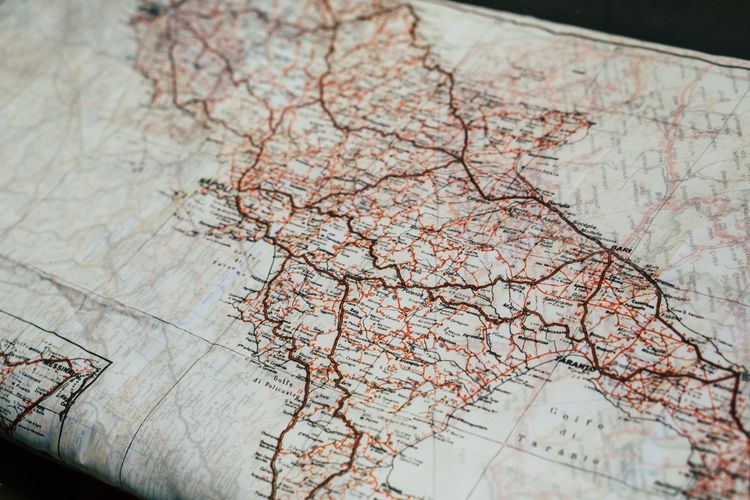Learning Strategy from First Principles - A Review of Wardley Maps

What's the first thing that comes to mind when you think about the word strategy? If you’re like most people you’ll come up with a version of “a plan to achieve a desired end.” If you look into the origin of the word however, it stems from stratagem which is a “plan or scheme to outwit an opponent” which I personally find more satisfying.
When you’re playing a game, like chess for example, you always have an objective – to capture the opponent’s king – but the strategy is not a fixed plan because it depends on what your opponent is doing, your position on the board, the pieces you have in play, etc. As you play, you might switch the strategy from playing defense to all out attacking to vying for position.
Wouldn’t it be cool if running an organization was more like this? That’s how I felt when first I heard about Simon Wardley’s blandley-titled Wardley Mapping book and watched a few presentations by the author on YouTube (He’s hilarious btw) The book is really long but it’s filled with examples and personal anecdotes from Wardely’s foray into business strategy.
In 2004, Wardley was the CEO of an online photo service business called Fotango. The book charts his journey from a confused CEO to one who got really close to building the first cloud computing company before AWS, only to be thwarted by his board. He later used the same techniques to take Ubuntu from an unknown Linux distribution to the most widely used.
I had been reading about business strategy for over a decade but I had never seen the big picture. After reading a few chapters of Wardley’s book and watching him speak, it finally clicked into place many of the loose strands and allowed me to synthesize the concept of strategy into two foundational principles that apply regardless of the domain being considered.
- Situational Awarness: Better situational awareness leads to better strategy.
- Gameplay: Strategy is a continuous cycle of moves not a linear plan.
Principle 1: Situational Awareness
If there is a core theme spanning the book, it’s the idea that the more you improve your situational awareness, the better your strategy gets. Without situational awareness, your strategy devolves to useless superlatives like “data driven synergies.”
So what is situational awareness? It’s a well known concept in military circles but not very well known elsewhere. Here’s a somewhat formal definition:
Situational awareness is the perception of the elements of a situation, the comprehension of their meaning and their projection into the future.
Adapted from "Designing for Situational Awareness" by Mica Endsely
All that means is that when you’re in a situation, you instinctively form a mental model of the situation based on what you perceive and what you can map to patterns you’ve seen before, a sort of “theory” of the situation that allows you to predict how it will unfold into the near future.
The quality of that mental model determines how close you are to being right about the situation and the quality of decisions you make in relation to that situation will be. This mental model will often suggest what moves you make next based on your objective.
For example, have you ever been in a situation where you were fully in the zone? When you could see what was happening with crystal clarity and anticipate others’ moves before they were made? This is known as "fingertip feel" and is a term used by John Boyd who was part of the inspiration for Wardley Maps.
The importance of maps in situational awareness
The next idea in the book is that maps are the best way to improve situational awareness and dictate strategic gameplays in business. There are six core elements for any map: visual representation, context specific, position of components relative to some form of anchor and movement of those components.
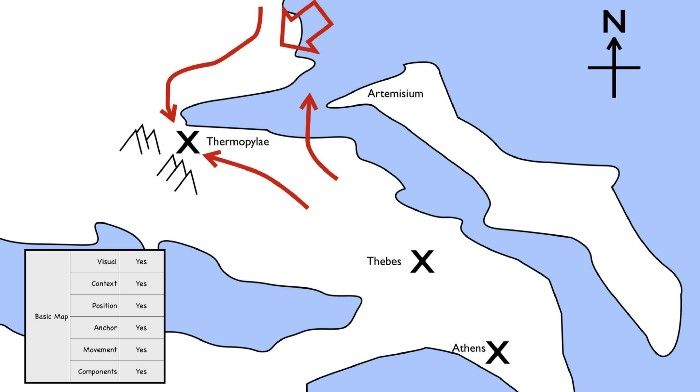
A chess board is an example of a map. It’s visual. It has a fixed orientation. It’s context specific to the game you’re playing. At any point in time, you can see the position of the pieces on the board and determine what move to make next.
A chess grandmaster can show up midway through the game, take one quick look at the board and instantly know what the next best move is.
Now imagine a chess game that has no board. You still have six pieces (a pawn, a rook, a knight, a bishop, a queen and a king) as does your opponent. You take turns making moves like in traditional chess, but there’s no board so you simply record sequences of moves.
A game might look like this: Pawn (white), Pawn (black), Pawn (w), Knight (b)…etc. Without a board there’s no way to tell what move to make next so you’re blindly making moves in hopes that they lead to checkmate.
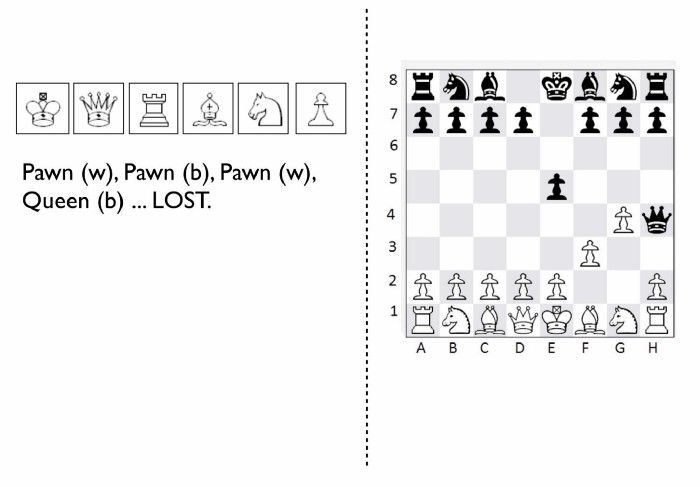
There might be academics who study this game and come up with sequences of moves that led to success in past games or you might try to copy the sequences verbatim but you’re still just throwing darts in the dark.
If that sounds unacceptable to you, just think about todayks business books. There are plenty of books by academics who gather lots of historical data about successful companies and try to discern the patterns of success. There’s even books by successful business operators espousing the virtues of this principle or that strategy that led to success.
But how do you know if the moves they made were right or wrong when the outcome might have been pure luck? At the end of the day that’s still like playing chess without a board or going into war without a map of the terrain.
Think about your garden variety heist movie (e.g. Ocean's Eleven) In every single one, you’ll see the thieves poring over blueprints of the terrain discussing context specific gameplay. Can you even imagine them planning their heist without blueprints?
Here’s another example of the importance of maps, this time in the context of war from the battle of Thermopylae immortalized in the movie 300.
The more I read into history, the clearer it became that understanding and exploiting the landscape had been vital in battle. Probably the most famously cited example is the ancient battle of the pass of Thermopylae. In 480 BC, the Athenian general Themistocles faced a significant foe in Xerxes and the Persian army. He had choices; he could defend around Thebes or Athens itself.
However, Themistocles understood the environment and decided to block off the straits of Artemisium forcing the Persian army along the coastal road into the narrow pass of Thermopylae known as the “Hot Gates”. In this terrain 4,000 odd Greeks would be able to hold back a Persian Army of 170,000 for many days enabling time for the rest of Greek city states to prepare. You’ve probably heard part of this story before in the tale of King Leonidas and the “three hundred” Spartans.
Simon Wardley - Wardley Maps Book
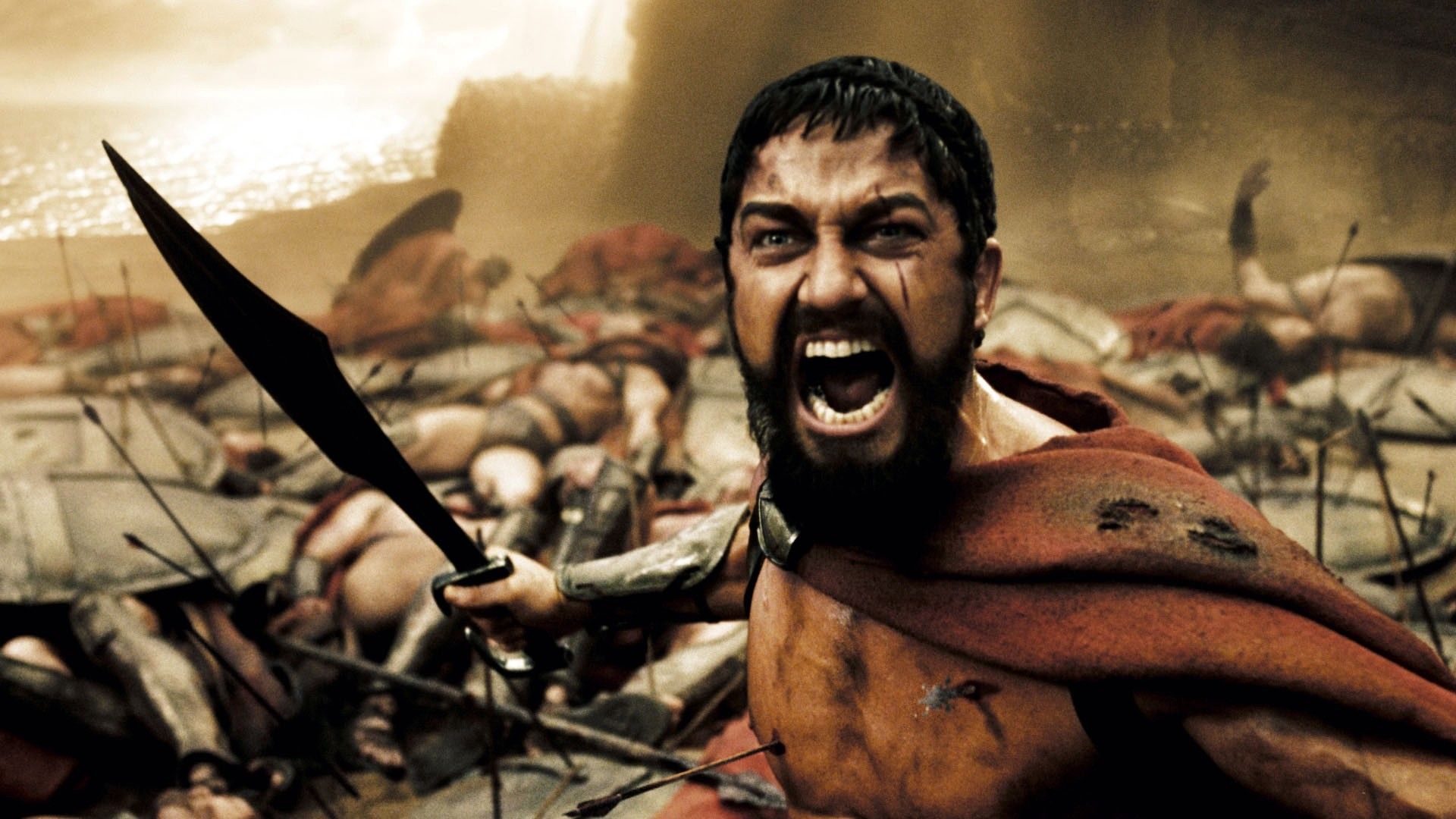
That’s why maps are important for getting situational awareness of what is going on. They allow you to “see the matrix” by observing the landscape, orienting to the situation and deciding what move to make next given your objective.
Imagine you had a map of the business landscape for your organization. How much easier would finding the right strategy be? That’s exactly what Wardley Maps gives you.
Principle 2: Gameplay and the Strategy Cycle
In the book Wardley explains how he stumbled upon Sun Tzu’s The Art of War and Boyd’s OODA loop which led him to the strategy cycle. I asked him recently on Twitter to explain how those elements related to Sun Tzu and he graciously replied.
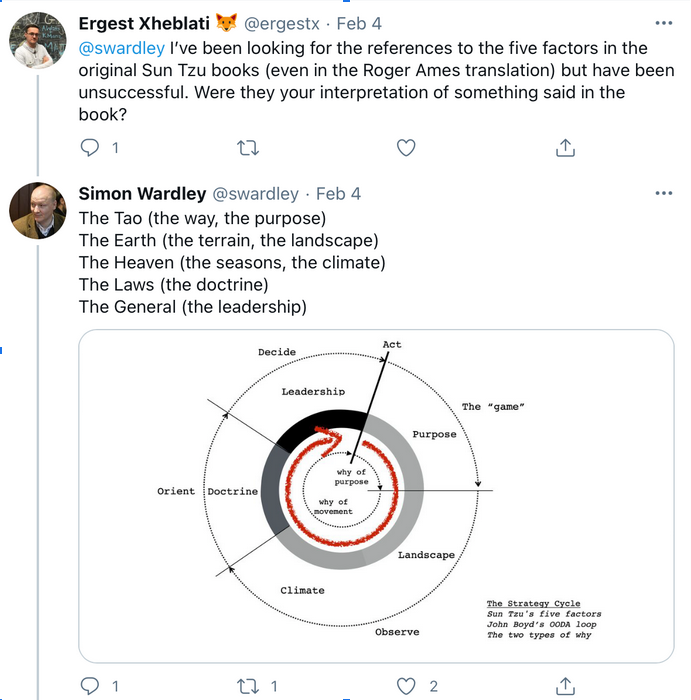
The strategy cycle demonstrates three important things:
- Strategy is a cycle. It’s not supposed to be a linear plan, it should evolve as you make moves and gain better situational awareness.
- Action is key By taking action you learn if your original strategy is still valid and how to adjust it.
- Purpose can change. Depending on the landscape, climatic patterns or the actions you take your original "why" could evolve.
Let’s look at the elements of the strategy cycle in the context of a game of chess:
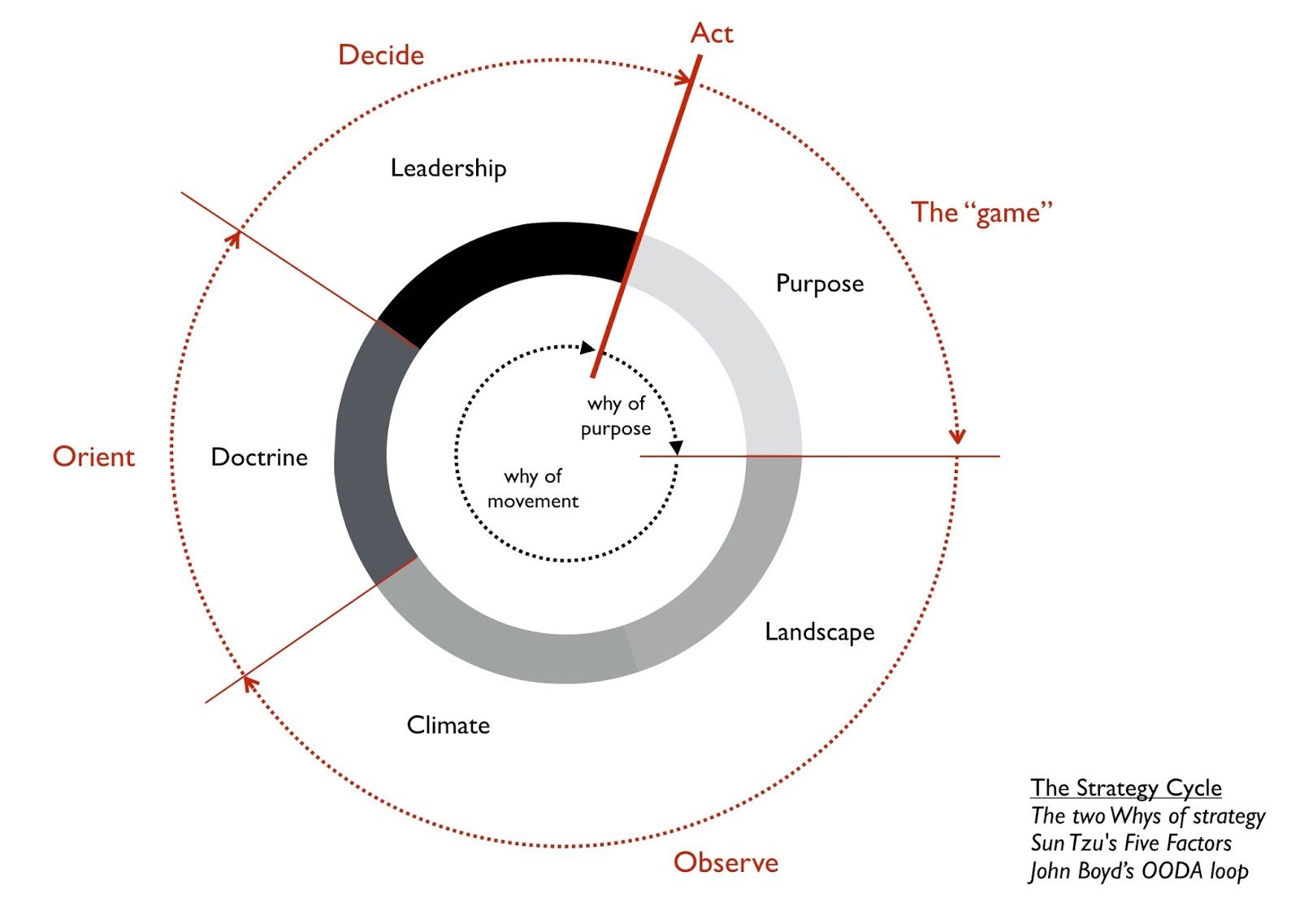
Purpose (aka the Tao)
The most important element of strategy is the purpose, or the why. There are two “why’s” in the cycle: the why of purpose and the why of movement.
In chess, the why of purpose is to capture your opponent’s king, but the why of movement is highly dependent on the current state of the board. You might make a move to defend against the onslaught of an attacking opponent, to counterattack, or to gain a better position on the board.
Compare that to many businesses these days. The why of purpose is a vague statement like “achieve strategic synergies” and the why of movement is random or opportunistic at best.
In an organization, the why of purpose is typically known as the mission statement. Wardley refers to it as the moral imperative. Very few organizations’ mission statements are even close to being a moral imperative. They are mostly feel-good platitudes.
Landscape (aka the terrain)
In chess the landscape or terrain is the gameboard. It indicates the position of the pieces and dictates movement. All organizations operate in a competitive landscape made up of competitors, laws, governmental policies, customers, employees, suppliers, buyers, sellers, etc.
Climate (aka the seasons)
The climate concept encapsulates the elements of the environment that happen regardless of your intervention. These can be thought of as the rules of the game. In chess for example this covers the ways pieces move on the board and how they capture each other.
For organizations, one of the most basic climatic patterns is that every component in the value chain is moving from the genesis stage where it is just starting out to the custom built stage, then towards the product stage and finally to the stage where it’s a commodity. (more on this in future posts but if you’re curious see the link at the end of the article)
Doctrine (aka the laws)
Doctrine is how you do things. Wardley calls them universal principles that appear to work regardless of the landscape. In chess, a good example of a doctrine is controlling the center of the board with your pieces. Regardless of specific strategies or what your opponent is doing, controlling the center of the board seems to be a good idea.
For organizations, one of the most basic doctrines is focusing on user needs. All value in business is created by meeting the needs of others. Product managers know this better than anyone given that their job is to represent the needs of users.
Leadership (aka the general)
Leadership is about the actions you take and specific gameplays. This is pretty clear in chess. For organizations, once you’ve taken into consideration your purpose, the landscape, climate and doctrine what moves do you choose to make? For organizations this means anything from “build vs buy”, capital allocation, mergers and acquisitions, etc.
So what do Wardley Maps look like?
Here’s the map I drew discussing the data industry.
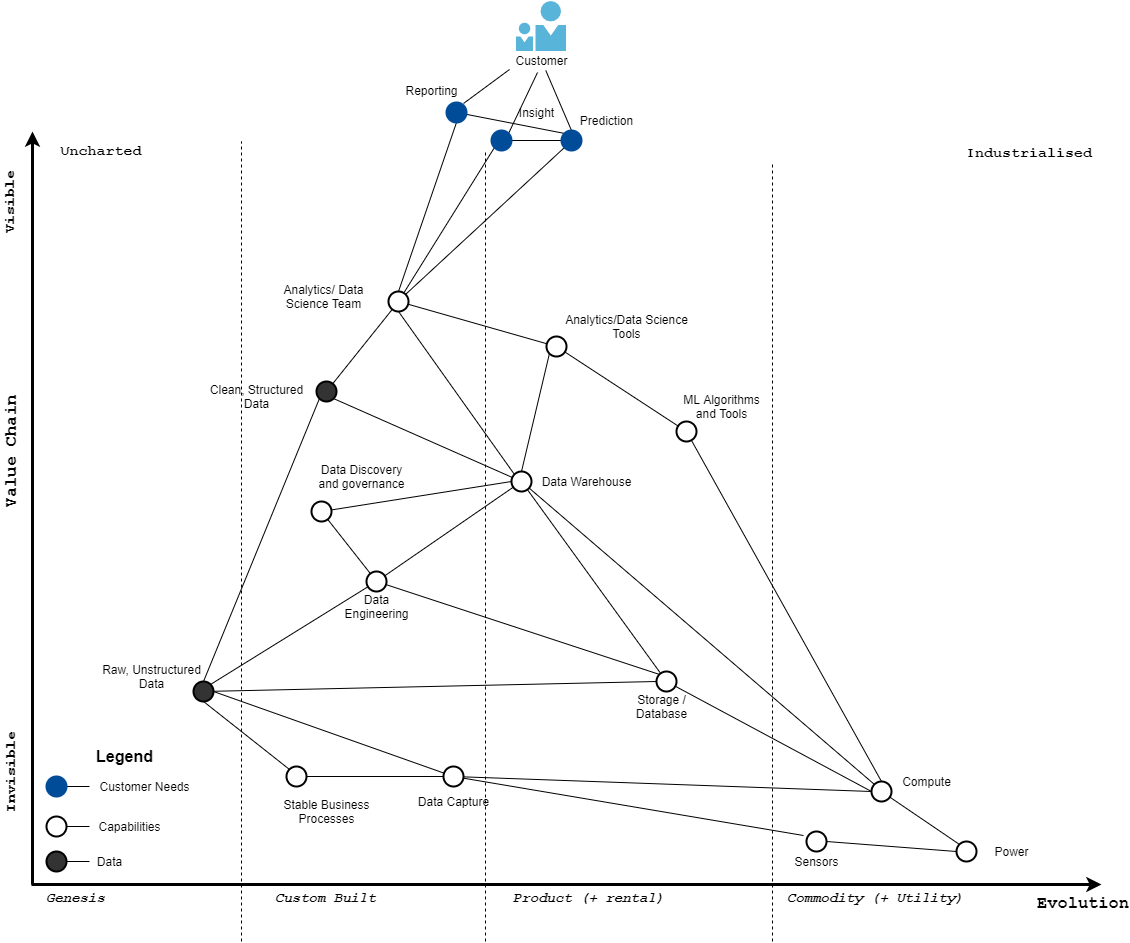
On the X axis, left to right you can see the evolution of components from Genesis to Commodity and on the Y axis you have the value chain going from Invisible to Visible. At the top the map is anchored by the Customer needs and the components of the value chain are placed according to their current stage of evolution.
This is a very quick overview of the basic elements. If you want more detail you can read my article on the state of the data industry here

